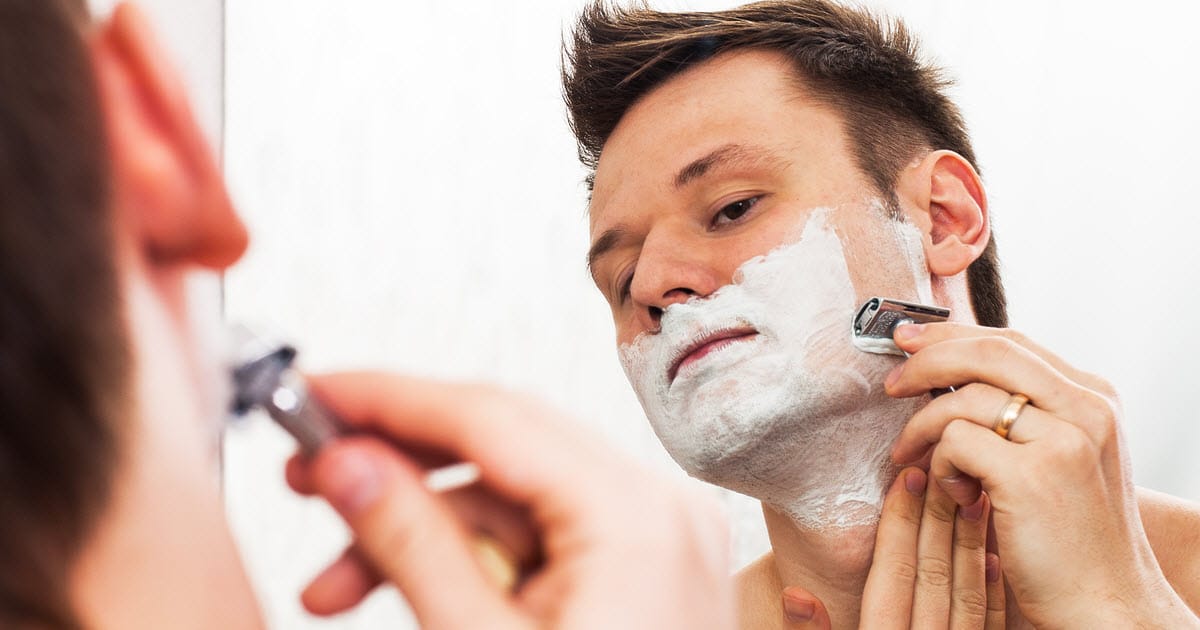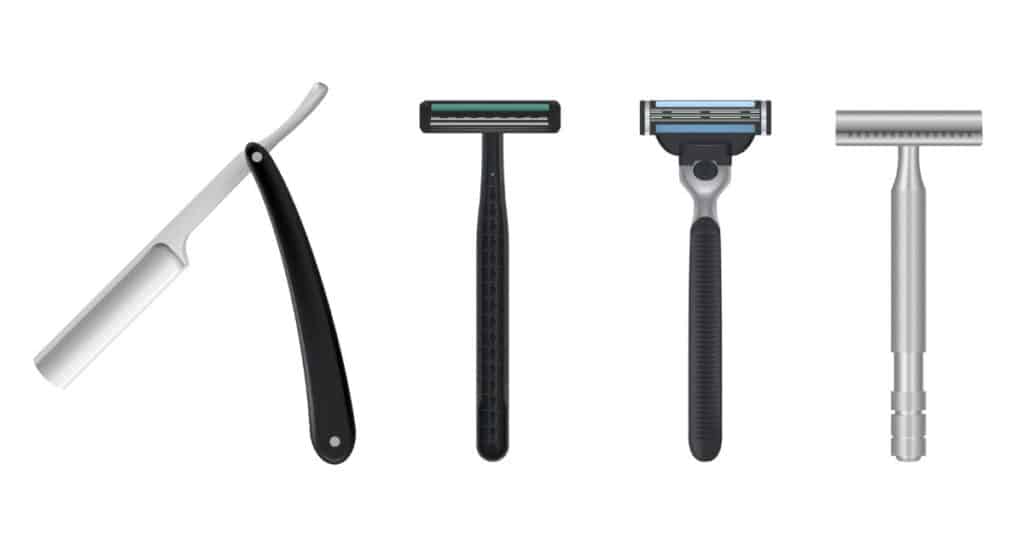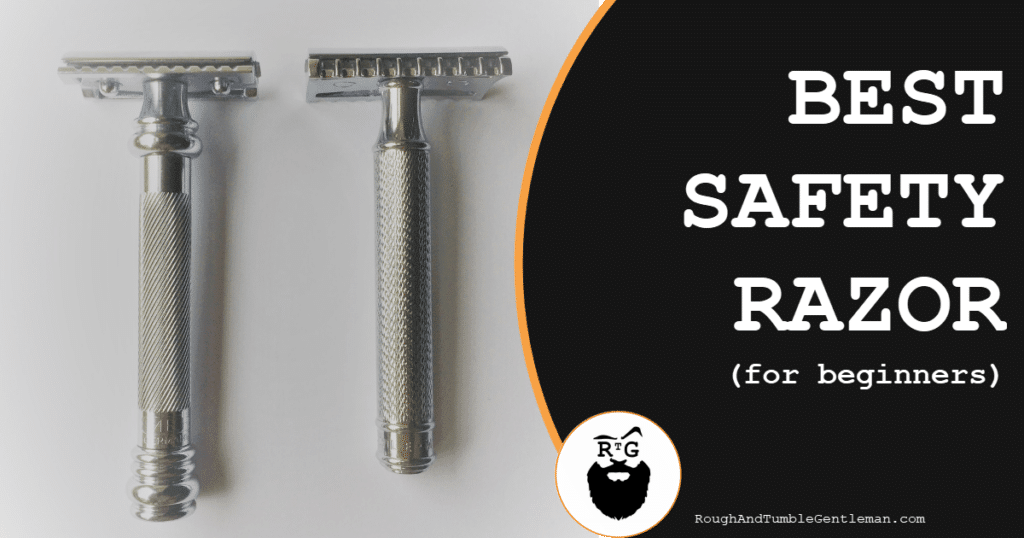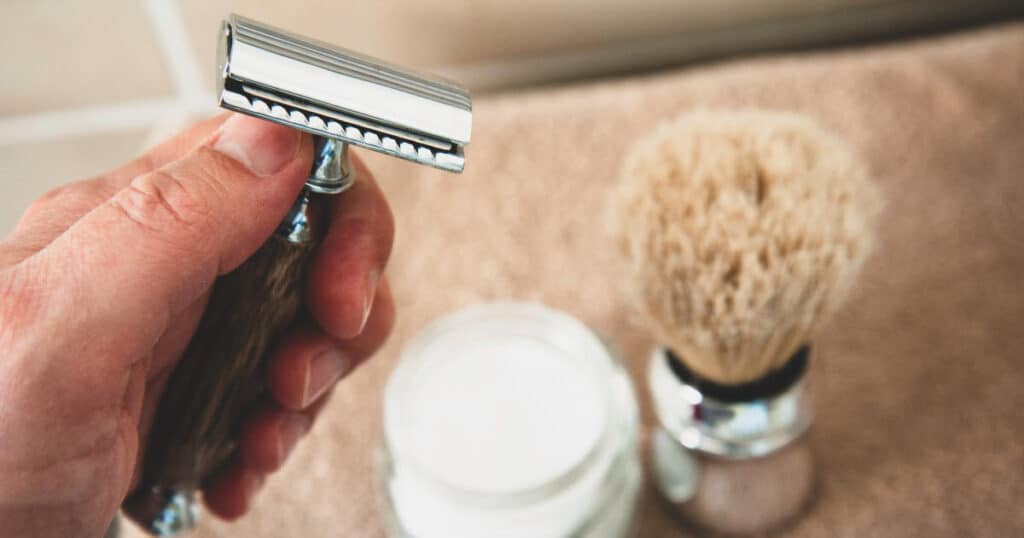Welcome to Rough and Tumble Gentleman! This is our “Intro to Wet Shaving” post. Below, we’ll talk about what wet shaving actually entails, the process, and the tools you’ll need. We’ll keep it simple, and introduce the concepts as simply as possible. Let’s start at the beginning: what is wet shaving?
We’ll start with a broad description, and then we’ll dive into the details. Here’s the broad description:
Wet Shaving Defined
Wet shaving is a method of removing the whiskers from your face using a traditional shaving brush, all-natural soaps, lathers, and oils, and a safety razor or a straight razor that features a single blade (as opposed to the disposable razors that typically have three or more blades). Wet shaving is the way that men shaved for centuries, until about the 1960s or 1970s, when disposable razors were popularized.
And… that’s it! At the heart of it, it’s pretty basic. It’s a simple, time-honored, old-school way to shave, and it’s basically shaving the same way your grandpa did, no matter where on the globe he came from.
The Process and the Gear
For many of us, the joy of wet shaving is the process.
The first—and perhaps most important—step is to soften your facial skin and whiskers. Most men shave after showering, and that’s a great way to get your skin relaxed, but you can also apply a warm, wet towel to your face. That’ll soften your facial hair, open your pores a little bit, and prepare your face for a close shave.
Next come the brush and lather. Creating a deep, rich lather is a particularly wonderful part of the process, and applying it after a shower is comforting and pleasant.
A typical shaving brush looks like this…

…but there are dozens of varieties, made with different handles and decor, and most importantly, different types of hairs on the brush: there are badger hair brushes, horsehair brushes, boars’ hair brushes, hybrid hair brushes made from a mix of badger or horsehair or boars’ hair, and synthetic brushes made from man-made materials. Each has a different feel and consistency—some are very soft (and work very well with shaving creams), and some are a little stiffer (and work well with shaving soaps). And, as with all things, each type of material has different price points. (Fun fact: the shaving forum Badger and Blade is a clever reference to shaving brushes and razors).
The lather is, for many men, the best part of the wet shaving experience. Traditional wet shavers typically use soaps or creams to create a lather. These usually contain all-natural ingredients, such as shea butter, aloe, lanoline, and Vitamin E; coconut oil, almost oil, and jojoba oil; and essential oils to make them smell amazing, like lavender, rose, peppermint, eucalyptus, lemon, cedarwood, sandalwood, and cypress. They almost always cost more than store-bought gels and foams, but they tend to last longer—”a little dab’ll do ya,” as they used to say.
The experience of using a mildly scented lather that’s designed to hold heat from the water in your shaving bowl is a wonderful experience, and it seems that the more serious you become about wet shaving, the more lathers you accumulate. There are many different types and varieties, and it’s nice to have options when you step up to the mirror in the morning—when you’re sleepy, a peppermint lather can invigorate you and make you feel more alert; if you’re a little anxious or grumpy, a calming lavender lather can be very comforting.
Remember: you CAN use gels and foams that you get out of aerosol cans—and millions upon millions of men do—but a finely crafted lather is simply more natural. There are some crazy ingredients in canned shaving cream, including propane—yes, propane, the same chemical you have in a gas grill—which is used to inflate the foam and push it out of the can. Many of those chemicals are known allergens and they can be brutal on your skin, and there are plenty of men who have very strong, and very adverse, reactions to them.
There’s one more item related to the brush and lather we want to mention: the shaving bowl. As with all things wet shaving, there are dozens of options, from stainless steel bowls to wooden cups to mugs with handles and emblems on them. This is another item that can be a lot of fun to acquire—some men collect coffee mugs, and get them as gifts from their girlfriends / wives / kids / colleagues; we seem to get shaving bowls as gifts from our girlfriends / wives / kids / colleagues, and that’s a-OK with us.
So you’ve pre-treated the skin and whiskers on your face, and whipped up a nice thick lather. Next step: the blade!
There are plenty of different types of razors—and we give a brief discussion of each in the next section—so we’ll give a quick overview of the actual “shaving” part of wet shaving:
Technique. The superiority of wet shaving over disposable shaving comes not only from the sharpness of the blade, but also the techniques used. Whereas most disposable shavers go once with or against the grain, wet shaving includes three passes: one pass with the grain, one pass across the grain, and one pass against the grain. If you visit a website or forum and people are discussing each of these passes, you may seem them abbreviated: with the grain is “WTG,” across the grain is “XTG,” and against the grain is “ATG.”
Three passes takes a little more time that the average shave, but it’s those three passes that make wet shaving so incredibly effective. Each pass attacks whiskers from a different angle, leaving your face as smooth as the skin on the inside of your arm. Using a disposable razor with three blades (along with the awful chemicals in canned shaving cream) to travel with, across, and against the grain would tear your sweet face into shreds—because in effect, it’s almost like you’re taking nine passes over your skin (three blades in a disposable razor multiplied by three passes over your skin = nine passes). Lunacy.
Angle. The angle of the razor blade to your skin is very important to the quality of your shave, and you’ll want to hold the blade against the skin your face at an angle of about 30 degrees (that is, if the angle of the floor is 0 degrees, you want to hold the blade at 30 degrees relative to the floor). That angle allows the best avenue of attack, and the blade is able to both slide over the skin and sever hairs while doing so.
Maneuvering the blade at 30 degrees can be tricky for men who are used to disposable razors, because disposable razors angle the razor at 30 degrees, so you don’t have to do it. Anytime you bring a disposable razor to your face, it’s automatically at 30 degrees. When you wet shave, you are responsible for keeping the razor at 30 degrees (or thereabouts), and that takes a little bit of practice. Many men who are new to wet shaving take it slow, and practice on the area of their skin underneath their ear and above the outside of their jaw, as that’s a relatively flat area that’s relatively safe from nicks. Once you get comfortable shaving that area, it’s on to the upper lip, chin, and neck.
And that’s it! You complete your three passes—WTG, XTG, and ATG—and you’re good to go. Some men use an aftershave when finish up, and those can also feel great and smell good (just as long as you don’t use too much; men of previous generations probably overdid it on the aftershave, but modern aftershave brands usually feature subtle aromas). The whole process takes anywhere from 10 to 20 minutes, depending on what you incorporate into your routine. It’s a little bit longer than shaving with a disposable razor, but it’s a lot more pleasant, and a LOT more effective.
There are a LOT of shaving tutorials on YouTube, and some are great, and some are… not so great. Here are two we like a lot. The first one is a bit longer (clocking in at about 17:00 minutes) and the second covers the same material, but is much shorter (clocking in at about 3 minutes).
Here’s the long one:
and here’s the short one:
Razors You Can Use
Next up in our “What is Wet Shaving?” run-down: the razor.
Perhaps the most difficult thing about getting into wet shaving is choosing a razor. There are many different types of razors—and variations of all those different types of razors—and that makes choosing one a little overwhelming. Here’s a (very) quick intro to the two most common types of wet shaving razors:
Safety Razors: Very Popular
With a solid, heavy handle, and a prominent head, safety razors are a very popular choice among wet shaving enthusiasts. Here’s an image of a safety razor:

There are a lot of different varieties of safety razor: there are double-edged safety razors, usually referred to as DE razors, that have blades on both sides of the head; there are single-edged safety razors, that have a blade on only one side of the head; and then there are dozens of different design types: there are one-, two-, and three-piece safety razors, safety razors with heads that are flat and others with heads that are slanted a little bit, and safety razors that have safety bars on them, in case you’re worried about cutting yourself. There are dozens of different varieties of safety razor, and the it seems the more you enjoy shaving, the types you want to try. We’ve written a long and in-depth post about different razors and all their unique qualities, and you can find that here.
Straight Razors: VERY Sharp
These are the “original gangsta” of razors, and they’re basically knives. They look like this:

and they’re INCREDIBLY sharp and incredibly effective. There are two main types: Western (the type you’ll find at high-end barber shops, if you were to go in and ask for a shave) and Kamisori (which are Japanese straight razors). Western razors are symmetrical, like a kitchen knife—if you laid a kitchen knife on a table, you’d see that it doesn’t actually lie flat against the table surface, and the blade tapers towards the sharp edge; whereas kamisoris are asymmetrical, and flat one side—so if you were to lie it on a table, it would actually lie flat against the table.
If that’s confusing to you, don’t worry—there are dozens of features to straight razors (including the shank, the shoulder, the spine, and so on) and straight razor enthusiasts go nuts over them. We’ve written a long post describing each part of a straight razor, so be sure to check it out if you’d like to learn more.
Straight razors take a steady hand a lot of practice. We usually advise that if you’re interested in wet shaving, it’s wisest to start with a safety razor, get the hang of that, and then work your way up to a straight razor. They’re gorgeous, but they’re unbelievably sharp.
If You’re a Little Concerned About Those Blades…
There are a lot of men who are used to shaving with disposable razors and want to make the jump to wet shaving, but they’re a little bit nervous. And that makes sense—when you wet shave, you’re getting a good close look at that razor blade, and that sucker looks sharp. With disposable razors, the blade is safely tucked away inside the plastic of the handle, and you can basically ignore it. You don’t have to consider that you’re bringing an incredibly sharp edge to a very sensitive part of your body.
Wet shaving, however, is a lot more “blade-centric,” and the blade is the star of the show. If you’re using a safety razor, you have to insert a fresh razor into the head, and you realize, for the first time, that shaving can be a little bit dangerous. And, the first time you use a straight razor, you’re realize you’re basically holding a small sword. You understand first-hand the severity of those blades, and it can be a little bit intimidating.
If that describes you and your situation, have no fear: plenty of men before you have made the jump, and plenty of men after you will make it, too.
For sure, you’ll probably get a few nicks and cuts when you make the transition from disposables to safety razors, but that’s the name of the game. You grab an alum block and rub it on the area of the cut to numb it a little bit, and you’re on your way. Practice makes perfect, and within a couple of shaves, most men are able to navigate their shave in a way that’s both comfortable and effective. In fact, many men report that once they figure out what they’re doing, they get fewer nicks and cuts from wet shaving, as compared to their old “disposable” shaving days.
It takes a little bit of responsibility and a little bit of practice, but it’s absolutely do-able.
There You Have It: What is Wet Shaving?
There you go! Wet shaving is an extremely pleasant, sensuous way of getting an incredibly close shave. If you need a list of reasons why wet shaving is the best thing ever, check out our post explaining why wet shaving is so rewarding. We had a great time writing it.
Have fun and be good!
Michael Morris is the head writer here at Rough and Tumble Gentleman. He's got a ducktail beard and loves Brazilian jiu-jitsu. He's married to the woman of his dreams and lives in Brooklyn, NY.




